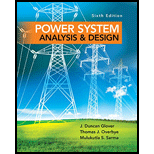
Power System Analysis and Design (MindTap Course List)
6th Edition
ISBN: 9781305632134
Author: J. Duncan Glover, Thomas Overbye, Mulukutla S. Sarma
Publisher: Cengage Learning
expand_more
expand_more
format_list_bulleted
Concept explainers
Textbook Question
Chapter 5, Problem 5.63P
Given the uncompensated line of Problem 5.18, let a three-phase shunt reactor (inductor) that compensates for
Expert Solution & Answer
Want to see the full answer?
Check out a sample textbook solution
Students have asked these similar questions
Why the Capacitance effect is neglected in Short Transmission Line.
Note please don’t handwringing
analyze the system parameters in terms of real/reactive power flow, real/reactive losses, voltage regulation and transmission line efficiency by varying the shunt reactor value?
analyze the system parameters in terms of real/reactive power flow, real/reactive losses, voltage regulation and transmission line efficiency by varying the shunt capacitor value?
conclusion for shunt compensation
one circuit of a sinlge phase transmission line is composed of three solid 0.5 cm radius wires. the return circuit is the composed of two solid 2.5 cm radius wire . the arrangement of conductors is as shwon in figure below. applying the concept of GMD and GMR , find the inductance of the complete line in millihenry per kilometer
Chapter 5 Solutions
Power System Analysis and Design (MindTap Course List)
Ch. 5 - Representing a transmission line by the two-port...Ch. 5 - The maximum power flow for a lossy line is...Ch. 5 - Prob. 5.21MCQCh. 5 - A 30-km, 34.5-kV, 60-Hz, three-phase line has a...Ch. 5 - A 200-km, 230-kV, 60-Hz, three-phase line has a...Ch. 5 - The 100-km, 230-kV, 60-Hz, three-phase line in...Ch. 5 - The 500-kV, 60-Hz, three-phase line in Problems...Ch. 5 - A 40-km, 220-kV, 60-Hz, three-phase overhead...Ch. 5 - A 500-km, 500-kV, 60-Hz, uncompensated three-phase...Ch. 5 - The 500-kV, 60-Hz, three-phase line in Problems...
Ch. 5 - A 350-km, 500-kV, 60-Hz, three-phase uncompensated...Ch. 5 - Rated line voltage is applied to the sending end...Ch. 5 - A 500-kV, 300-km, 6()-Hz, three-phase overhead...Ch. 5 - The following parameters are based on a...Ch. 5 - Consider a long radial line terminated in its...Ch. 5 - For a lossless open-circuited line, express the...Ch. 5 - A three-phase power of 460 MW is transmitted to a...Ch. 5 - Prob. 5.55PCh. 5 - Consider the transmission line of Problem 5.18....Ch. 5 - Given the uncompensated line of Problem 5.18, let...
Knowledge Booster
Learn more about
Need a deep-dive on the concept behind this application? Look no further. Learn more about this topic, electrical-engineering and related others by exploring similar questions and additional content below.Similar questions
- Transmission line conductance is usually neglected in power system studies. True Falsearrow_forwardA three-phase power of 460 MW is transmitted to a substation located 500 km from the source of power. With VS=1. per unit, VR=0.9 per unit, =5000 km, Zc=500, and =36.87, determine a nominal voltage level for the lossless transmission line based on Eq. (5.4.29) of the text. Using this result, find the theoretical three-phase maximum power that can be transferred by the lossless transmission line.arrow_forwardFor either single-phase two-wire line or balanced three-phase three-wire line with equal phase spacing D and with conductor radius r, the capacitance (line-to-neutral) in F/m is given by Can=.arrow_forward
- The capacitance of a single-circuit, three-phase transposed line with the configuration shown in Figure 4.38, including ground effect, and with conductors not equilaterally spaced is given by C20lnDeqrlnHmH8 F/m line-to-neutral where Deq=D12D23D133=GMD r= conductors outside radiusHm=(H12H23H13)1/3HS=(H1H2H3)1/3 Now consider Figure 4.39 in which the configuration of a three-phase, single circuit, 345-kV line with conductors having an outside diameter of 1.065 in. is shown. Determine the capacitance to neutral in F/m, including the ground effect. Next, neglecting the effect of ground, see how the value changes.arrow_forwardDescribe the effect of resistive load on sending and receiving end voltages, Power transferred and Power factor.arrow_forwardRated line voltage is applied to the sending end of the line in Problem 5.26. Calculate the receiving-end voltage when the receiving end is terminated by (a) an open circuit, (b) the surge impedance of the line, and (c) one-half of the Surge impedance. (d) Also calculate the theoretical maximum real power that the line can deliver when rated voltage is applied to both ends of the line.arrow_forward
- A 350-km, 500-kV, 60-Hz, three-phase uncompensated line has a positive-sequence series reactance x=0.34/km and a positive-sequence shunt admittance y=j4.5106S/km. Neglecting losses, calculate: (a) Zc,. (b) l, (c) the ABCD parameters, (d) the wavelength of the line in kilometers, and (e) the surge impedance loading in MW.arrow_forwardThe following parameters are based on a preliminary line design: per unitVS=1.0, VR=0.9 per unit, =5000km,Zc=320,=36.8. A three-phase power of 700 MW is to be transmitted to a substation located 315 km from the source of power. (a) Determine a nominal voltage level for the three-phase transmission line, based on the practical line-loadability equation. (b) For the voltage level obtained in part (a), determine the theoretical maximum power that can be transferred by the line.arrow_forward
arrow_back_ios
arrow_forward_ios
Recommended textbooks for you
 Power System Analysis and Design (MindTap Course ...Electrical EngineeringISBN:9781305632134Author:J. Duncan Glover, Thomas Overbye, Mulukutla S. SarmaPublisher:Cengage Learning
Power System Analysis and Design (MindTap Course ...Electrical EngineeringISBN:9781305632134Author:J. Duncan Glover, Thomas Overbye, Mulukutla S. SarmaPublisher:Cengage Learning

Power System Analysis and Design (MindTap Course ...
Electrical Engineering
ISBN:9781305632134
Author:J. Duncan Glover, Thomas Overbye, Mulukutla S. Sarma
Publisher:Cengage Learning
Types of Energy for Kids - Renewable and Non-Renewable Energies; Author: Smile and Learn - English;https://www.youtube.com/watch?v=w16-Uems2Qo;License: Standard Youtube License